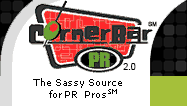
Perfect Pitching
Watch Out for Those Little Sons of Pitches
Originally Posted
Updated
Somebody once said (perhaps you know the source), "Be careful of what you wish for; you may get it." This is often an appropriate reminder for newcomers to publicity, who may be lulled, seduced, or misled into thinking of certain kinds of appearances as "big scores" when, indeed, they turn out to be "big snores." We thought it might be appropriate to review a few examples. First, though, some time-proven basics. The four phases of accomplishment in marketing communications -- visibility, credibility, authority, and leadership -- each requires its predecessor. There's no one mention that can help you or harm you enough to make much difference in the long run. And today's news wraps tomorrow's garbage. At the moment, these may sound like bumper stickers, but do keep them in mind as we go through our examples. Imagine you have a brand new company with a brand new Whatzis. You jot down a few alternatives to consider as goals for your publicity program:
-
Interviews with your CEO.
-
A company-authored article in a magazine that accepts them.
-
A five-city press tour.
-
A cable video news spot.
-
A radio talk show appearance for your president.
All five should prove fantastic flops; let's look at why. You Wanna Change Your Order? In the vernacular, "spitting in the wind" offers a fair explanation why an interview with your CEO is out of sequence. CEO interviews are a wonderful way to build a company's authority, but first you have to establish the credibility of the CEO's and the company's position or what little interest you may muster will be tempered by skepticism. In turn, you can't well expect to establish any credibility for an unknown company or product or individual, so visibility is a necessary first mandate. Isn't this true -- in every case -- for the interviews that you read -- and certainly for the ones you care about? So why, you may ask, do so many publicists try to leapfrog those first two steps? There are several answers to this last question, but none of them are flattering to publicists. Don't You Trust Me? While we're exploiting introspection, consider the magazines you read that accept vendor-authored articles. Do you trust these articles? Do you believe them to be objective? Do you hold these magazines in high regard? Are they the magazines you'd turn to first when making a purchase decision? With a very few exceptions (notably academic, scientific, and medical professional journals), there is no such magazine that its readers hold in very high regard; however, the same subject in the hands of an accomplished journalist, often balanced by coverage of other vendors in the market niche, are among those most trusted by readers. The energy it takes to create a single, authored article is better when channeled into a White Paper or press briefing that can reach the many authors, journalists, and freelancers who cover the subject -- especially those who write for the top publications in the market. Touring the Hot Spots Press tours are among the most expensive publicity activities you will ever consider undertaking. They may or may not be among the most effective. Here are a few guidelines:
-
Don't schedule them just before, during, or just after major trade shows or popular vacation periods.
-
Schedule them before your major news announcements and be prepared to pre-brief your hosts on what you have coming; be sure there's a clear understanding of the ground rules in terms of embargoes and permissible leaks.
-
Prepare presentations and demonstrations that are as brief as possible, and leave plenty of time for the editors to try things out for themselves; leave something behind, if at all possible.
-
Have competitive price and feature information at hand, and don't stonewall answers to questions (it's better to say "We don't know yet" or "I can only answer that completely off the record for now, as background only").
-
And make very sure that you make your appointment with all of the right people -- the reporter on that beat, the reviewer for that kind of product, the First Looks editor, whomever.
The cable news spot and radio talk show appearance both manifest the same weakness: It's unlikely that you will reach an audience of buyers. Consider an advertising metaphor: You might be able to reach 100 percent of your target by placing ads in TV Guide, Playboy, and People, but you'd be buying 98+ percent waste circulation. Getting Wasted Targeting isn't just important as a return on the energy you invest, but also as a way of preventing the enormous load on your resources that comes when you have to respond to misguided interest from "waste audience" people who may be curious about your product, but who will never become your customers. The basics of publicity -- visibility efforts, reinforcement, positioning, benefit communications -- may seem more boring or less exciting than the kind of high-profile activities we've talked about here, but they didn't become the basics by accident. These are the activities that establish your presence in a marketplace and get you sales. Once they begin taking effect, the sexier high-profile activities become not only appropriate, but necessary. In this age of instant gratification, patience is a difficult virtue to exercise, but rewards you in ways that quick thrills never could.

